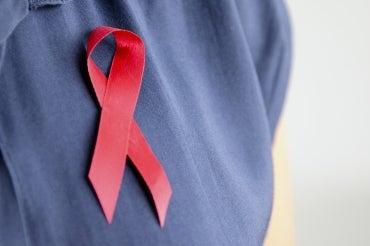Public health researchers at U of T launch first Canadian study on couples with different HIV statuses

Published: November 30, 2016
Tomorrow is World AIDS Day, and this year’s theme is Disclosure: HIV/AIDS in the 21st Century.
 This theme is particularly relevant for Thom and Vajdon (pictured left), who have been together for 17 years and are in what scientists call a serodiscordant relationship – where one partner is HIV-positive and the other is HIV-negative.
This theme is particularly relevant for Thom and Vajdon (pictured left), who have been together for 17 years and are in what scientists call a serodiscordant relationship – where one partner is HIV-positive and the other is HIV-negative.
“There are a lot of us out here, living full and loving lives. Sticking by each other no matter what,” said Thom (on the left side of the photo), a writer, actor and educator who is HIV-positive and lives in Toronto with his partner Vajdon (on the right side of the photo), who is a PhD student.
This summer, U of T’s Dalla Lana School of Public Health launched Positive Plus One, the first Canadian study about HIV-serodiscordant relationships. These relationships are increasingly common, since people with HIV are living longer lives and have more opportunity for longer relationships.
Thom will be featured with Liviana Calzavara, a professor at Dalla Lana, who launched Positive Plus One, tomorrow on CTV's "Your Morning" for World AIDS Day and then at 5:15 p.m. on CBC Radio's "Here & Now."
Positive Plus One brings together a diverse team of community members, AIDS service organizations and clinicians. Researchers say they hope the results will inform health-care professionals, service providers, policy-makers and those living in HIV-serodiscordant relationships about how to improve knowledge and services for HIV-positive people and their HIV-negative partners.
According to the Ontario HIV Treatment Network Cohort Study, 23 per cent of HIV-positive people reported an HIV-negative regular partner. People in HIV-serodiscordant relationships face many unique challenges, including stigma and the risk of transmission between partners, but scientists, policy-makers and service providers know relatively little about how these factors affect people.
For the study to be successful, researchers say, they must hear the voices of both partners to get the perspectives of both HIV-positive and HIV-negative persons. They're looking for couples from different backgrounds – of all genders, ethnicities, sexual identities and regions of the country.
Thom and Vajdon say they hope the study will help to reduce stigma through awareness and education.
“While the consequences of stigma are better known for positive people, their negative partners are deeply affected, too,” said Vajdon. “It’s important to highlight the experiences of negative partners, and ensure that HIV support programs and policies take their needs into account.”
 Calzavara (pictured right) is an HIV/AIDS research pioneer. She oversaw the Toronto Sexual Contact Study, the first cohort study to examine the natural history of HIV infection and the role of sexual risk behaviours. She also co-developed and co-taught the first HIV/AIDS course offered at U of T.
Calzavara (pictured right) is an HIV/AIDS research pioneer. She oversaw the Toronto Sexual Contact Study, the first cohort study to examine the natural history of HIV infection and the role of sexual risk behaviours. She also co-developed and co-taught the first HIV/AIDS course offered at U of T.
Together with a number of HIV/AIDS researchers at Dalla Lana including Professor Emeritus Ted Myers and Assistant Professor Dan Allman, Calzavara has led significant international research into the behavioural determinants of HIV transmission among men who have sex with men.



